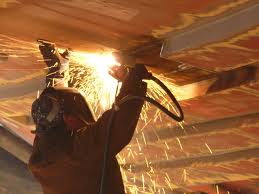
The Alaska Marine Highway System could be another casualty of federal budget battles. Money used to repair and maintain the aging ferry fleet could become much tighter in the near future.
The small ferry LeConte needs renovated crew quarters, upgraded wiring and a new coat of paint – plus engine and other work. That’ll cost nearly $9 million.
The mainliner Columbia has to have new engines. That’s expected to run around $25 million. And the list goes on.
How does it get paid for? Alaska Marine Highway chief Mike Neussl says a lot of the money comes from the U.S. government.
“There is a real potential that our federal funding will decrease. And we will need to make that up somehow, either through state general funds or changing the amount of maintenance that we do or saving money someplace else,” he says.
Neussl says the state gets about $17.5 million each year from the Federal highway and transit agencies. A state match brings it up to about $22 million. Still other appropriations come our way from Washington, D.C.
Congress last month voted to extend highway funding, including marine highways, for another six months. And the program’s formulas, including ferry set-asides, will remain.
But that’s expected to change.
Alaska’s Congressional delegation is optimistic, but realistic.
“Anything that’s been subsidized by federal dollars is under a threat,” says Representative Don Young, a member of the House Committee on Transportation and Infrastructure.
He’s watching a ferry-funding bill being pushed by Washington state Congressman Rick Larsen. Young has cosponsored similar measures in the past.
“This time I didn’t because I want a better formula for Alaska. I’ve told him, ‘You put my formula in there that we had before, and I’ll be very supportive of it,’ ” Young says.
There’s also Senate ferry legislation.
Senators Lisa Murkowski and Mark Begich cosponsored the measure with Washington state’s Patty Murray.
“As one from the Pacific Northwest, she understands that ferries are not necessarily a luxury. This is not a cruise ship that you’re putting your car on. This is our transportation system,” Murkowski says.
Murray is in a good position to support ferry funding.
She chairs the transportation panel of the Senate Appropriations Committee, which assembles highway and ferry budgets. She also co-chairs Congress’ debt-reduction super-committee.
Begich says the ferry bill may not pass on its own. But it could advance marine transportation.
“Making sure we have a piece of legislation out there is critical so we create kind of a marker so when we get into the highway transportation bill, this is one of the items that needs to be discussed,” Begich says.
The Parnell administration is also watching for funding declines. But it’s not sounding the alarm.
“The boats will be safe and in good condition to run,” says Randy Ruaro, the governor’s deputy chief of staff. He says the state may have to chip in more. “In the last several years we’ve seen some supplemental requests for some maintenance and rehabilitation work. And I think the Legislature has approved those on each occasion.”
Less federal money would bring more legislative requests.
There’s about $16 million for ferry terminals in Kodiak and Prince Rupert, $4.5 million for emergency evacuation slides — and the list continues.
